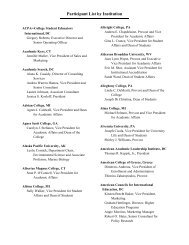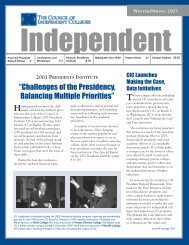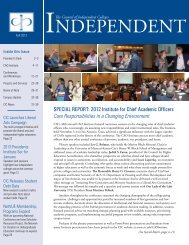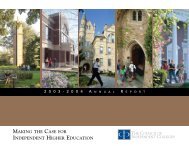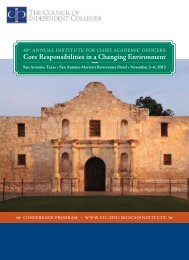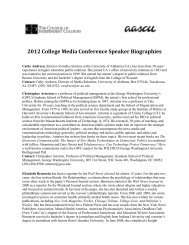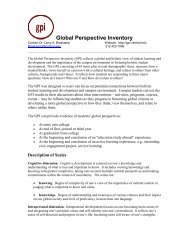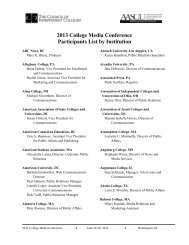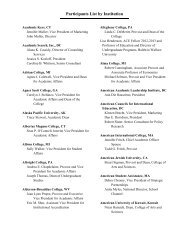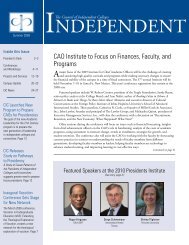Meeting the Challenge: - The Council of Independent Colleges
Meeting the Challenge: - The Council of Independent Colleges
Meeting the Challenge: - The Council of Independent Colleges
You also want an ePaper? Increase the reach of your titles
YUMPU automatically turns print PDFs into web optimized ePapers that Google loves.
Small by Design: Resilience in an Era <strong>of</strong> Mass Higher Education<br />
<strong>The</strong> small independent colleges in <strong>the</strong> United States have been remarkable<br />
<strong>the</strong>ir broad traditional commitments to collegiate education<br />
and international management. Drury University extended<br />
its traditional liberal arts curriculum to embrace a school<br />
<strong>of</strong> architecture and half a dozen master’s programs in<br />
pr<strong>of</strong>essional fields as varied as criminology, communication,<br />
and instructional technology. Goddard College in Vermont<br />
continued its innovative impulses, which go back to <strong>the</strong><br />
school’s founding in 1938, with master’s programs in<br />
consciousness studies; nature, culture, and healing; and<br />
transformative language arts. Shenandoah University in<br />
Virginia <strong>of</strong>fered a variety <strong>of</strong> master’s programs through its<br />
school <strong>of</strong> health pr<strong>of</strong>essions and conservatory <strong>of</strong> music.<br />
Antioch College branched out from its historic<br />
Ohio campus to establish law schools in several metropolitan<br />
areas, characterized by an innovative, public serviceoriented<br />
approach to legal education—a bold move that was<br />
philosophically consistent with an undergraduate curriculum<br />
that emphasized work experience. Some liberal arts<br />
institutions, such as Capital University in Ohio, Chapman<br />
University in California, McKendree College in Illinois,<br />
Mercy College in New York, and Saint Leo University in<br />
Florida, added programs beyond <strong>the</strong>ir home campus that<br />
were tailored to nontraditional constituencies, including<br />
working adults and personnel at educationally underserved<br />
locations such as military bases.<br />
Diversity within <strong>the</strong> group <strong>of</strong> private colleges has<br />
not precluded cooperation with peer institutions. Since its<br />
chartering in 1962, <strong>the</strong> Great Lakes <strong>Colleges</strong> Association<br />
(GLCA) has provided a national model for an effective,<br />
coherent consortium. Its fundamental bond is a commitment<br />
to teaching and learning, as members share expertise and<br />
pool resources and facilities across multiple independent<br />
college campuses, in areas ranging from international<br />
programs to technological innovation. Its members include<br />
12 independent liberal arts colleges in Michigan, Indiana,<br />
and Ohio. In Illinois, Wisconsin, Iowa, and Minnesota,<br />
a dozen colleges formed <strong>the</strong> Associated <strong>Colleges</strong> <strong>of</strong> <strong>the</strong><br />
Midwest at about <strong>the</strong> same time that <strong>the</strong> GLCA began.<br />
Nine small colleges and universities in <strong>the</strong> South<br />
formed <strong>the</strong>ir own consortium in 1991, <strong>the</strong> Associated<br />
<strong>Colleges</strong> <strong>of</strong> <strong>the</strong> South, and soon it had grown to 16 members.<br />
In <strong>the</strong> multi-state area <strong>of</strong> Kentucky, Tennessee, Virginia,<br />
West Virginia, and North Carolina, <strong>the</strong> Appalachian College<br />
Association, incorporated in 1990, now brings toge<strong>the</strong>r 35<br />
colleges that assist one ano<strong>the</strong>r and also compete effectively<br />
34



